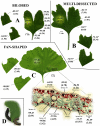Ginkgo biloba responds to herbivory by activating early signaling and direct defenses
- PMID: 22448229
- PMCID: PMC3308967
- DOI: 10.1371/journal.pone.0032822
Ginkgo biloba responds to herbivory by activating early signaling and direct defenses
Abstract
Background: Ginkgo biloba (Ginkgoaceae) is one of the most ancient living seed plants and is regarded as a living fossil. G. biloba has a broad spectrum of resistance or tolerance to many pathogens and herbivores because of the presence of toxic leaf compounds. Little is known about early and late events occurring in G. biloba upon herbivory. The aim of this study was to assess whether herbivory by the generalist Spodoptera littoralis was able to induce early signaling and direct defense in G. biloba by evaluating early and late responses.
Methodology/principal findings: Early and late responses in mechanically wounded leaves and in leaves damaged by S. littoralis included plasma transmembrane potential (Vm) variations, time-course changes in both cytosolic calcium concentration ([Ca(2+)](cyt)) and H(2)O(2) production, the regulation of genes correlated to terpenoid and flavonoid biosynthesis, the induction of direct defense compounds, and the release of volatile organic compounds (VOCs). The results show that G. biloba responded to hebivory with a significant Vm depolarization which was associated to significant increases in both [Ca(2+)](cyt) and H(2)O(2). Several defense genes were regulated by herbivory, including those coding for ROS scavenging enzymes and the synthesis of terpenoids and flavonoids. Metabolomic analyses revealed the herbivore-induced production of several flavonoids and VOCs. Surprisingly, no significant induction by herbivory was found for two of the most characteristic G. biloba classes of bioactive compounds; ginkgolides and bilobalides.
Conclusions/significance: By studying early and late responses of G. biloba to herbivory, we provided the first evidence that this "living fossil" plant responds to herbivory with the same defense mechanisms adopted by the most recent angiosperms.
Conflict of interest statement
Figures







Similar articles
-
Plasma membrane potential depolarization and cytosolic calcium flux are early events involved in tomato (Solanum lycopersicon) plant-to-plant communication.Plant Sci. 2012 Nov;196:93-100. doi: 10.1016/j.plantsci.2012.08.006. Epub 2012 Aug 14. Plant Sci. 2012. PMID: 23017903
-
Robotic mechanical wounding (MecWorm) versus herbivore-induced responses: early signaling and volatile emission in Lima bean (Phaseolus lunatus L.).Planta. 2010 Aug;232(3):719-29. doi: 10.1007/s00425-010-1203-0. Epub 2010 Jun 19. Planta. 2010. PMID: 20563731
-
Separation of early and late responses to herbivory in Arabidopsis by changing plasmodesmal function.Plant J. 2013 Jan;73(1):14-25. doi: 10.1111/j.1365-313X.2012.05103.x. Epub 2012 Nov 8. Plant J. 2013. PMID: 22775399
-
The neuroprotective properties of the Ginkgo biloba leaf: a review of the possible relationship to platelet-activating factor (PAF).J Ethnopharmacol. 1996 Mar;50(3):131-9. doi: 10.1016/0378-8741(96)01379-7. J Ethnopharmacol. 1996. PMID: 8691847 Review.
-
Recent advances in plant early signaling in response to herbivory.Int J Mol Sci. 2011;12(6):3723-39. doi: 10.3390/ijms12063723. Epub 2011 Jun 7. Int J Mol Sci. 2011. PMID: 21747702 Free PMC article. Review.
Cited by
-
Large Scale Screening of Ethnomedicinal Plants for Identification of Potential Antibacterial Compounds.Molecules. 2016 Mar 14;21(3):293. doi: 10.3390/molecules21030293. Molecules. 2016. PMID: 26985889 Free PMC article.
-
Construction of anti-codon table of the plant kingdom and evolution of tRNA selenocysteine (tRNASec).BMC Genomics. 2020 Nov 19;21(1):804. doi: 10.1186/s12864-020-07216-3. BMC Genomics. 2020. PMID: 33213362 Free PMC article.
-
Functional and morphological evolution in gymnosperms: A portrait of implicated gene families.Evol Appl. 2019 Jul 21;13(1):210-227. doi: 10.1111/eva.12839. eCollection 2020 Jan. Evol Appl. 2019. PMID: 31892953 Free PMC article.
-
Deciphering the Role of Ion Channels in Early Defense Signaling against Herbivorous Insects.Cells. 2021 Aug 27;10(9):2219. doi: 10.3390/cells10092219. Cells. 2021. PMID: 34571868 Free PMC article. Review.
-
Identification of Powdery Mildew Responsive Genes in Hevea brasiliensis through mRNA Differential Display.Int J Mol Sci. 2016 Jan 29;17(2):181. doi: 10.3390/ijms17020181. Int J Mol Sci. 2016. PMID: 26840302 Free PMC article.
References
-
- Jacobs BP, Browner WS. Ginkgo biloba: A living fossil. Am J Med. 2000;108:341–342. - PubMed
-
- Zhou ZY, Zheng SL. Palaeobiology: The missing link in Ginkgo evolution - The modern maidenhair tree has barely changed since the days of the dinosaurs. Nature. 2003;423:821–822. - PubMed
-
- Royer DL, Hickey LJ, Wing SL. Ecological conservatism in the “living fossil” Ginkgo. Paleobiology. 2003;29:84–104.
-
- Hasebe M. Moleculary phylogeny of Ginkgo biloba: close relationship between Ginkgo biloba and cycads. In: Hori Y, Ridge RW, Tulecke W, Del Tredici P, Tremouillaux-Guiller J, Tobe H, editors. Ginkgo biloba-a Global Treasure. Tokyo: Springer-Verlag; 1997. pp. 173–181.
-
- Zhao YP, Paule J, Fu CX, Koch MA. Out of China: Distribution history of Ginkgo biloba L. Taxon. 2010;59:495–504.
Publication types
MeSH terms
Substances
LinkOut - more resources
Full Text Sources
Miscellaneous

